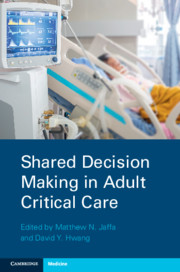Book contents
- Shared Decision Making in Adult Critical Care
- Shared Decision Making in Adult Critical Care
- Copyright page
- Dedication
- Contents
- Contributors
- Preface
- Chapter 1 When Does Shared Decision-Making Apply in Adult Critical Care?
- Chapter 2 How Much Does the Family Want to Be Involved in Decision-Making?
- Chapter 3 Show Me the Data
- Chapter 4 Communication Skills for Critical Care Family Meetings
- Chapter 5 The Do-Not-Resuscitate Order
- Chapter 6 The Do-Not-Intubate Order
- Chapter 7 Prolonged Ventilator Dependence for the Pulmonary Patient
- Chapter 8 Renal Replacement Therapy
- Chapter 9 Shared Decision-Making during Extracorporeal Membrane Oxygenation
- Chapter 10 Hypoxic–Ischemic Brain Injury after Cardiac Arrest
- Chapter 11 Decompressive Craniectomy for Stroke Patients
- Chapter 12 Decompressive Craniectomy for Traumatic Brain Injury Patients
- Chapter 13 Severe Traumatic Spinal Cord Injury
- Chapter 14 Potentially Inappropriate Treatment and Conscientious Objection
- Chapter 15 Shared Decision-Making in Emergent Situations
- Chapter 16 Advance Directives
- Chapter 17 Care of the Unbefriended Patient
- Chapter 18 The Role of Palliative Care in the Intensive Care Unit
- Chapter 19 Measuring and Evaluating Shared Decision-Making in the Intensive Care Unit
- Chapter 20 Brain Death Discussions
- Index
- References
Chapter 15 - Shared Decision-Making in Emergent Situations
Published online by Cambridge University Press: 27 May 2021
- Shared Decision Making in Adult Critical Care
- Shared Decision Making in Adult Critical Care
- Copyright page
- Dedication
- Contents
- Contributors
- Preface
- Chapter 1 When Does Shared Decision-Making Apply in Adult Critical Care?
- Chapter 2 How Much Does the Family Want to Be Involved in Decision-Making?
- Chapter 3 Show Me the Data
- Chapter 4 Communication Skills for Critical Care Family Meetings
- Chapter 5 The Do-Not-Resuscitate Order
- Chapter 6 The Do-Not-Intubate Order
- Chapter 7 Prolonged Ventilator Dependence for the Pulmonary Patient
- Chapter 8 Renal Replacement Therapy
- Chapter 9 Shared Decision-Making during Extracorporeal Membrane Oxygenation
- Chapter 10 Hypoxic–Ischemic Brain Injury after Cardiac Arrest
- Chapter 11 Decompressive Craniectomy for Stroke Patients
- Chapter 12 Decompressive Craniectomy for Traumatic Brain Injury Patients
- Chapter 13 Severe Traumatic Spinal Cord Injury
- Chapter 14 Potentially Inappropriate Treatment and Conscientious Objection
- Chapter 15 Shared Decision-Making in Emergent Situations
- Chapter 16 Advance Directives
- Chapter 17 Care of the Unbefriended Patient
- Chapter 18 The Role of Palliative Care in the Intensive Care Unit
- Chapter 19 Measuring and Evaluating Shared Decision-Making in the Intensive Care Unit
- Chapter 20 Brain Death Discussions
- Index
- References
Summary
Ms. Patterson is a 68-year-old woman with a history of hypertension who was at home when she developed a sudden-onset severe headache with vomiting. She called 911 but was obtunded on arrival of emergency medical services and could give no further history. She was brought to the emergency department (ED) within 40 minutes of the onset of headache. On arrival to the ED, her blood pressure is 205/110 mmHg and her heart rate is 90; she is taking shallow breaths with a respiratory rate of 32 breaths per minute with an oxygen saturation of 94%. She has a fixed pupil on the left and does not withdraw from painful stimulus on the right. Her family arrives 20 minutes later, and by then a computed tomography (CT) scan has been performed, showing a 7-cm intracerebral hemorrhage (ICH) with a “spot sign” on the CT angiogram. The spot sign describes an area of contrast enhancement within a hemorrhage that serves as an independent predictor of ICH expansion and poor outcome. On return from the CT, she has a Glasgow Coma Scale of 7.
- Type
- Chapter
- Information
- Shared Decision Making in Adult Critical Care , pp. 133 - 142Publisher: Cambridge University PressPrint publication year: 2021



